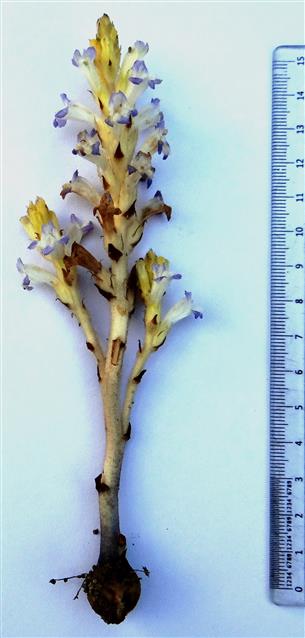OROBANCHACEAE
Mostly herbaceous root-parasites, without chlorophyll, scapigerous. Stem usually unbranched, often fleshy. Leaves scale-like. Inflorescence racemose, spicate, subcapitate, rarely 1-flowered; bract 1, scaly, leaf-like; bractlets (or bracteoles) 2, adnate to base of calyx or pedicel. Flowers bisexual, zygomorphic, hypogynous, blue, violet, yellowish to brown. Calyx tubular, cupulate or campanulate, 2-5-lobed or -toothed or -parted or spathe-like, persistent, scaly, occasionally absent or 3 sepals free. Corolla 2-lipped, usually curved, tubular-campanulate or funnelform with 5 subequal lobes, upper lip entire, emarginate or 2-lobed; lower lip 3-lobed. Stamens 4, didynamous, inserted at base of corolla tube, anthers mostly connivent (arched inwards so that the points meet); filaments filiform, often hairy at the base, usually included; anthers bithecous, dehiscing longitudinally, rarely 1 theca imperfect and spurred. Carpels 2-3, syncarpous; ovary superior, 1(-2)-locular, with numerous ovules on (2-)4(-6) parietal placentas, sometimes axile placentas at base of ovary; style simple, often long with curved tip and +/- bilobed stigma. Fruit an ovoid to oblong capsule, 1-celled, dehiscing into 2 incompletely separating valves, glabrous, usually many-seeded. Seeds very small.
99 genera and more than 2000 species
